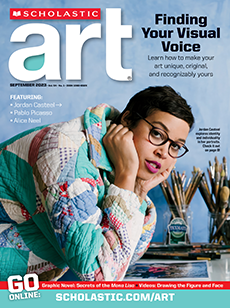Illuminated manuscripts are handwritten books decorated with painted pictures or designs. They are usually thought of as an art of the Middle Ages. During that time beautifully decorated Bibles and prayer books were produced to glorify God and to teach religious doctrine. Often, gold leaf (a thin layer of gold) was added to the decoration. The brilliant metal seemed to light up the pages of the manuscript. For this reason, the manuscripts were called "illuminated," from a Latin word that means "to light up."
Illustrated books have been made throughout the ages. Manuscripts decorated with drawings have been found in Egyptian tombs. It is believed that the ancient Greeks and Romans illustrated some texts, such as works on science and medicine. Some of the first elaborately decorated manuscripts were made in the eastern part of the Roman Empire, later called the Byzantine Empire, by professional scribes (copyists) and illuminators. By the 600's, the work of writing and illustrating religious manuscripts had been taken over by monks. The art of manuscript illumination spread throughout western Europe.
The monks worked in monasteries, in special rooms called scriptoria. At first, the monks simply copied the old manuscripts. But later they began to create new books. One group of monks copied the text onto pages made of parchment or vellum, types of prepared animal skin. The manuscript was then given to illuminators. They decorated it using thick watercolor paints and gold leaf.
Some of the decorations in illuminated manuscripts were small pictures, called miniatures. The term "minatures" comes from the Latin word minium, or "red lead." Minium was often used as a pigment by early illuminators. (Today, the word "miniature" refers to any small picture.) The pictures did not always illustrate the text. And they did not always have religious subjects, such as images of saints or scenes from the Bible. Sometimes they depicted everyday scenes.
Other manuscript decorations were purely ornamental. Pages were bordered with designs that made a frame for the text. Some designs were based on plant or animal forms. Other designs combined these forms with complex patterns of interlaced lines and geometric shapes. Often the first letter of a new section of text was enlarged and elaborately decorated. These initial letters sometimes filled an entire page.
During the 1100's, Europe's first universities were formed. Monasteries began to decline as centers of learning. Illuminated manuscripts were again created by artists working outside the church. Among these later manuscripts were collections of romances, books about animals and plants, and other nonreligious works. Then, in the 1400's, the printing press was invented. Hand-lettered manuscripts with hand-painted decorations gradually were replaced by printed books with illustrations, such as woodcuts or engravings, that could be reproduced along with the text.
